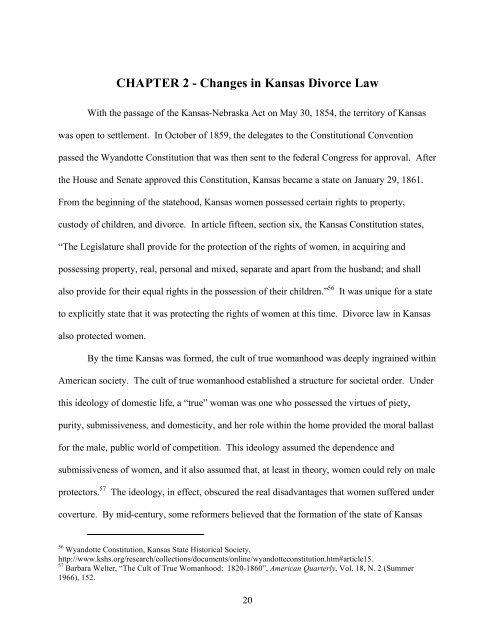SELFISH INTENTIONS - K-REx - Kansas State University
SELFISH INTENTIONS - K-REx - Kansas State University
SELFISH INTENTIONS - K-REx - Kansas State University
You also want an ePaper? Increase the reach of your titles
YUMPU automatically turns print PDFs into web optimized ePapers that Google loves.
CHAPTER 2 - Changes in <strong>Kansas</strong> Divorce Law<br />
With the passage of the <strong>Kansas</strong>-Nebraska Act on May 30, 1854, the territory of <strong>Kansas</strong><br />
was open to settlement. In October of 1859, the delegates to the Constitutional Convention<br />
passed the Wyandotte Constitution that was then sent to the federal Congress for approval. After<br />
the House and Senate approved this Constitution, <strong>Kansas</strong> became a state on January 29, 1861.<br />
From the beginning of the statehood, <strong>Kansas</strong> women possessed certain rights to property,<br />
custody of children, and divorce. In article fifteen, section six, the <strong>Kansas</strong> Constitution states,<br />
“The Legislature shall provide for the protection of the rights of women, in acquiring and<br />
possessing property, real, personal and mixed, separate and apart from the husband; and shall<br />
also provide for their equal rights in the possession of their children.” 56 It was unique for a state<br />
to explicitly state that it was protecting the rights of women at this time. Divorce law in <strong>Kansas</strong><br />
also protected women.<br />
By the time <strong>Kansas</strong> was formed, the cult of true womanhood was deeply ingrained within<br />
American society. The cult of true womanhood established a structure for societal order. Under<br />
this ideology of domestic life, a “true” woman was one who possessed the virtues of piety,<br />
purity, submissiveness, and domesticity, and her role within the home provided the moral ballast<br />
for the male, public world of competition. This ideology assumed the dependence and<br />
submissiveness of women, and it also assumed that, at least in theory, women could rely on male<br />
protectors. 57 The ideology, in effect, obscured the real disadvantages that women suffered under<br />
coverture. By mid-century, some reformers believed that the formation of the state of <strong>Kansas</strong><br />
56 Wyandotte Constitution, <strong>Kansas</strong> <strong>State</strong> Historical Society,<br />
http://www.kshs.org/research/collections/documents/online/wyandotteconstitution.htm#article15.<br />
57 Barbara Welter, “The Cult of True Womanhood: 1820-1860”, American Quarterly, Vol. 18, N. 2 (Summer<br />
1966), 152.<br />
20

















